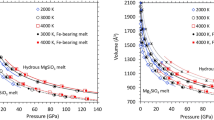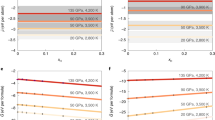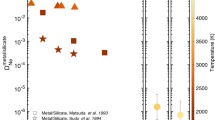Abstract
Melting processes in the deep mantle have important implications for the origin of the deep-derived plumes believed to feed hotspot volcanoes such as those in Hawaii1. They also provide insight into how the mantle has evolved, geochemically and dynamically, since the formation of Earth2. Melt production in the shallow mantle is quite well understood, but deeper melting near the core–mantle boundary remains controversial. Modelling the dynamic behaviour of deep, partially molten mantle requires knowledge of the density contrast between solid and melt fractions. Although both positive and negative melt buoyancies can produce major chemical segregation between different geochemical reservoirs, each type of buoyancy yields drastically different geodynamical models. Ascent or descent of liquids in a partially molten deep mantle should contribute to surface volcanism or production of a deep magma ocean, respectively. We investigated phase relations in a partially molten chondritic-type material under deep-mantle conditions. Here we show that the iron partition coefficient between aluminium-bearing (Mg,Fe)SiO3 perovskite and liquid is between 0.45 and 0.6, so iron is not as incompatible with deep-mantle minerals as has been reported previously3. Calculated solid and melt density contrasts suggest that melt generated at the core–mantle boundary should be buoyant, and hence should segregate upwards. In the framework of the magma oceans induced by large meteoritic impacts on early Earth, our results imply that the magma crystallization should push the liquids towards the surface and form a deep solid residue depleted in incompatible elements.
This is a preview of subscription content, access via your institution
Access options
Subscribe to this journal
Receive 51 print issues and online access
$199.00 per year
only $3.90 per issue
Buy this article
- Purchase on Springer Link
- Instant access to full article PDF
Prices may be subject to local taxes which are calculated during checkout




Similar content being viewed by others
References
Lay, T., Garnero, E. J. & Williams, Q. Partial melting in a thermo-chemical boundary layer at the base of the mantle. Phys. Earth Planet. Inter. 146, 441–467 (2004)
Solomatov, V. S. in Origin of the Earth and Moon (eds Canup, R. M. & Righter, K. ) 323–338 (Univ. Arizona Press, 2000)
Nomura, R. et al. Spin crossover and iron-rich silicate melt in the Earth's deep mantle. Nature 473, 199–202 (2011)
Hernlund, J. W. & Jellinek, A. M. Dynamics and structure of a stirred partially molten ultralow-velocity zone. Earth Planet. Sci. Lett. 296, 1–8 (2010)
Rost, S., Garnero, E. J., Williams, Q. & Manga, M. Seismological constraints on a possible plume root at the core–mantle boundary. Nature 435, 666–669 (2005)
Laporte, D., Toplis, M. J., Seyler, M. & Devidal, J. L. A new experimental technique for extracting liquids from peridotite at very low degrees of melting: application to partial melting of depleted peridotite. Contrib. Mineral. Petrol. 146, 463–484 (2004)
McNamara, A. K., Garnero, E. J. & Rost, S. Tracking deep mantle reservoirs with ultra-low velocity zones. Earth Planet. Sci. Lett. 299, 1–9 (2010)
Buffett, B. A., Garnero, E. J. & Jeanloz, R. Sediments at the top of Earth's core. Science 290, 1338–1342 (2000)
Sakai, T. et al. Interaction between iron and post-perovskite at core-mantle boundary and core signature in plume source region. Geophys. Res. Lett. 33, L15317 (2006)
Andrault, D. et al. Melting curve of the deep mantle applied to properties of early magma ocean and actual core-mantle boundary. Earth Planet. Sci. Lett. 304, 251–259 (2011)
Fiquet, G. et al. Melting of peridotite to 140 gigapascals. Science 329, 1516–1518 (2010)
Mosenfelder, J. L., Asimow, P. D., Frost, D. J., Rubie, D. C. & Ahrens, T. J. The MgSiO3 system at high pressure: thermodynamic properties of perovskite, postperovskite, and melt from global inversion of shock and static compression data. J. Geophys. Res. 114, B01203 (2009)
Stixrude, L., de Koker, N., Sun, N., Mookherjee, M. & Karki, B. B. Thermodynamics of silicate liquids in the deep Earth. Earth Planet. Sci. Lett. 278, 226–232 (2009)
Funamori, N. & Sato, T. Density contrast between silicate melts and crystals in the deep mantle: an integrated view based on static-compression data. Earth Planet. Sci. Lett. 295, 435–440 (2010)
Ito, E., Kubo, A., Katsura, T. & Walter, M. J. Melting experiments of mantle materials under lower mantle conditions with implications for magma ocean differentiation. Phys. Earth Planet. Inter. 143–144, 397–406 (2004)
Litasov, K. & Ohtani, E. Phase relations and melt compositions in CMAS–pyrolite–H2O system up to 25 GPa. Phys. Earth Planet. Inter. 134, 105–127 (2002)
Trønnes, R. G. & Frost, D. J. Peridotite melting and mineral–melt partitioning of major and minor elements at 22–24.5 GPa. Earth Planet. Sci. Lett. 197, 117–131 (2002)
Zhang, J. & Herzberg, C. Melting experiments on anhydrous peridotite KLB-1 from 5.0 to 22.5 GPa. J. Geophys. Res. 99, 17729–17742 (1994)
Ohtani, E., Moriwaki, K., Kato, T. & Onuma, K. Melting and crystal–liquid partitioning in the system Mg2SiO4–Fe2SiO4 to 25 GPa. Phys. Earth Planet. Inter. 107, 75–82 (1998)
Walter, M. J., Nakamura, E., Trønnes, R. G. & Frost, D. J. Experimental constraints on crystallization differentiation in a deep magma ocean. Geochim. Cosmochim. Acta 68, 4267–4284 (2004)
Wood, B. J. & Rubie, D. C. The effect of alumina on phase transformations at the 660-kilometer discontinuity from Fe–Mg partitioning experiments. Science 273, 1522–1524 (1996)
Auzende, A.-L. et al. Element partitioning between magnesium silicate perovskite and ferropericlase: new insights into bulk lower-mantle geochemistry. Earth Planet. Sci. Lett. 269, 164–174 (2008)
Kobayashi, Y. et al. Fe–Mg partitioning between (Mg, Fe)SiO3 post-perovskite, perovskite and magnesiowüstite in the Earth’s lower mantle. Geophys. Res. Lett. 32, L19301 (2005)
Andrault, D. et al. Experimental evidence for perovskite and post-perovskite coexistence throughout the whole D" region. Earth Planet. Sci. Lett. 293, 90–96 (2010)
Murakami, M., Hirose, K., Sata, N. & Ohishi, Y. Post-perovskite phase transition and mineral chemistry in the pyrolitic lowermost mantle. Geophys. Res. Lett. 32, L03304 (2005)
Davaille, A. A simultaneous generation of hotspots and superswells by convection in a heterogeneous planetary mantle. Nature 402, 756–760 (1999)
Labrosse, S., Hernlund, J. W. & Coltice, N. A crystallizing dense magma ocean at the base of the Earth's mantle. Nature 450, 866–869 (2007)
Hirose, K., Shimizu, N., van Westrenen, W. & Fei, Y. Trace element partitioning in Earth's lower mantle and implications for geochemical consequences of partial melting at the core-mantle boundary. Phys. Earth Planet. Inter. 146, 249–260 (2004)
Corgne, A., Liebske, C., Wood, B. J., Rubie, D. C. & Frost, D. J. Silicate perovskite-melt partitioning of trace elements and geochemical signature of a deep perovskitic reservoir. Geochim. Cosmochim. Acta 69, 485–496 (2005)
Liebske, C., Corgne, A., Frost, D. J., Rubie, D. C. & Wood, B. J. Compositional effects on element partitioning between Mg-silicate perovskite and silicate melts. Contrib. Mineral. Petrol. 149, 113–128 (2005)
Sata, N., Shen, G., Rivers, M. L. & Sutton, S. R. Pressure–volume equation of state of the high-pressure B2 phase of NaCl. Phys. Rev. B 65, 114114–114117 (2002)
Hammersley, J. Fit2d User Manual (ESRF, 1996)
Larson, A. C. & Von Dreele, R. B. GSAS Manual (Los Alamos National Laboratory, 1988)
Miyajima, N., Fujino, K., Funamori, N., Kondo, T. & Yagi, T. Garnet–perovskite transformation under conditions of the Earth's lower mantle: an analytical transmission electron microscopy study. Phys. Earth Planet. Inter. 116, 117–131 (1999)
Petitgirard, S. et al. An in situ approach to study trace element partitioning in the laser heated diamond anvil cell. Rev. Sci. Instrum. 83, 013904 (2012)
Manning, C. E., Wilke, M., Schmidt, C. & Cauzid, J. Rutile solubility in albite-H2O and Na2Si3O7-H2O at high temperatures and pressures by in-situ synchrotron radiation micro-XRF. Earth Planet. Sci. Lett. 272, 730–737 (2008)
Mayanovic, R. A., Yan, H., Anderson, A. J., Meredith, P. R. & Bassett, W. A. In situ X-ray absorption spectroscopic study of the adsorption of Ni2+ on Fe3O4 nanoparticles in supercritical aqueous fluids. J. Phys. Chem. C 116, 2218–2225 (2012)
Wilke, M. et al. A confocal set-up for micro-XRF and XAFS experiments using diamond-anvil cells. J. Synchrotron Radiat. 17, 669–675 (2010)
Sanchez-Valle, C. et al. Dissolution of strontianite at high P–T conditions: an in-situ synchrotron X-ray fluorescence study. Am. Mineral. 88, 978–985 (2003)
Petitgirard, S. et al. A diamond anvil cell for X-ray fluorescence measurements of trace elements in fluids at high pressure and high temperature. Rev. Sci. Instrum. 80, 033906 (2009)
Acknowledgements
We thank N. Bolfan-Casanova, M. A. Bouhifd, T. Druitt, T. Hammouda and J.-M. Hénot for help and discussions. This work is supported by the French National Centre for Scientific Research’s National Institute for Earth Sciences and Astronomy, the ESRF and the European C2C programme. This is Laboratory of Excellence ClerVolc contribution no. 26.
Author information
Authors and Affiliations
Contributions
D.A., S.P., G.L.N., G.G. and M.M. synthesized the sample and took the XRD and XRF measurements at the ID27 beamline. S.P. and G.V. took the XRF measurements at the ID21 beamline. D.A. and J.-L.D. performed the electron-probe micro-analyses at the Laboratoire Magmas et Volcans. D.A., S.P. and G.L.N. performed the data treatment and wrote the paper. All authors discussed the results and commented on the manuscript.
Corresponding author
Ethics declarations
Competing interests
The authors declare no competing financial interests.
Supplementary information
Supplementary Information
This file contains Supplementary Text, Supplementary References, Supplementary Tables 1-2 and Supplementary Figures 1-5. (PDF 918 kb)
Rights and permissions
About this article
Cite this article
Andrault, D., Petitgirard, S., Lo Nigro, G. et al. Solid–liquid iron partitioning in Earth’s deep mantle. Nature 487, 354–357 (2012). https://doi.org/10.1038/nature11294
Received:
Accepted:
Published:
Issue Date:
DOI: https://doi.org/10.1038/nature11294
This article is cited by
-
Moon-forming impactor as a source of Earth’s basal mantle anomalies
Nature (2023)
-
Magma Ocean, Water, and the Early Atmosphere of Venus
Space Science Reviews (2023)
-
Chemical analysis of trace elements at the nanoscale in samples recovered from laser-heated diamond anvil cell experiments
Physics and Chemistry of Minerals (2022)
-
Formation of bridgmanite-enriched layer at the top lower-mantle during magma ocean solidification
Nature Communications (2020)
-
Continent-sized anomalous zones with low seismic velocity at the base of Earth's mantle
Nature Geoscience (2016)
Comments
By submitting a comment you agree to abide by our Terms and Community Guidelines. If you find something abusive or that does not comply with our terms or guidelines please flag it as inappropriate.



